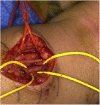Median and/or Ulnar Nerve Fascicle Transfer for the Restoration of Elbow Flexion in Upper Neonatal Brachial Plexus Palsy
- PMID: 30775115
- PMCID: PMC6359913
- DOI: 10.2106/JBJS.ST.M.00070
Median and/or Ulnar Nerve Fascicle Transfer for the Restoration of Elbow Flexion in Upper Neonatal Brachial Plexus Palsy
Abstract
Introduction: Transfer of a fascicle of the ulnar and/or median nerve to the musculocutaneous nerve in order to reinnervate the biceps and/or brachialis muscles has a high success rate and a low rate of complications in infants with upper (C5-C6) or extended upper (C5-C7) neonatal brachial plexus palsy.
Step 1 make the incision: Make a longitudinal incision along the midline of the middle third of the medial brachium.
Step 2 mobilize the musculocutaneous nerve: The musculocutaneous nerve is typically found on the undersurface of the biceps muscle.
Step 3 mobilize the median nerve: The median nerve runs along the neurovascular sheath medial to the brachial artery.
Step 4 mobilize the ulnar nerve: The ulnar nerve lies posterior to the intermuscular septum.
Step 5 transfer the donor nerve to the recipient nerve: Cut the donor fascicles distally and the recipient fascicles proximally to facilitate transfer.
Step 6 close the wound: Irrigate the wound, and close it in layers.
Step 7 postoperative protocol: Remove the bandages two weeks postoperatively, and encourage passive range-of-motion exercises.
Results: In our series, thirty-one patients underwent single or combined nerve fascicle transfer; twenty-seven (87%) obtained functional elbow flexion recovery (Active Movement Scale [AMS] score ≥ 6) while twenty-four (77%) obtained full elbow flexion recovery (AMS score = 7). Indications Contraindications Pitfalls & Challenges.
Figures











References
-
- Waters PM. Comparison of the natural history, the outcome of microsurgical repair, and the outcome of operative reconstruction in brachial plexus birth palsy. J Bone Joint Surg Am. 1999 May;81( 5):649-59. - PubMed
-
- Little KJ Zlotolow DA Soldado F Cornwall R Kozin SH. Early functional recovery of elbow flexion and supination following median and/or ulnar nerve fascicle transfer in upper neonatal brachial plexus palsy. J Bone Joint Surg Am. 2014 Feb 5;96( 3):215-21. - PubMed
-
- Kozin SH. Nerve transfers in brachial plexus birth palsies: indications, techniques, and outcomes. Hand Clin. 2008 Nov;24( 4):363-76, v. - PubMed
-
- Oberlin C Béal D Leechavengvongs S Salon A Dauge MC Sarcy JJ. Nerve transfer to biceps muscle using a part of ulnar nerve for C5-C6 avulsion of the brachial plexus: anatomical study and report of four cases. J Hand Surg Am. 1994 Mar;19( 2):232-7. - PubMed
-
- Noaman HH Shiha AE Bahm J. Oberlin’s ulnar nerve transfer to the biceps motor nerve in obstetric brachial plexus palsy: indications, and good and bad results. Microsurgery. 2004;24( 3):182-7. - PubMed
LinkOut - more resources
Full Text Sources
Miscellaneous
